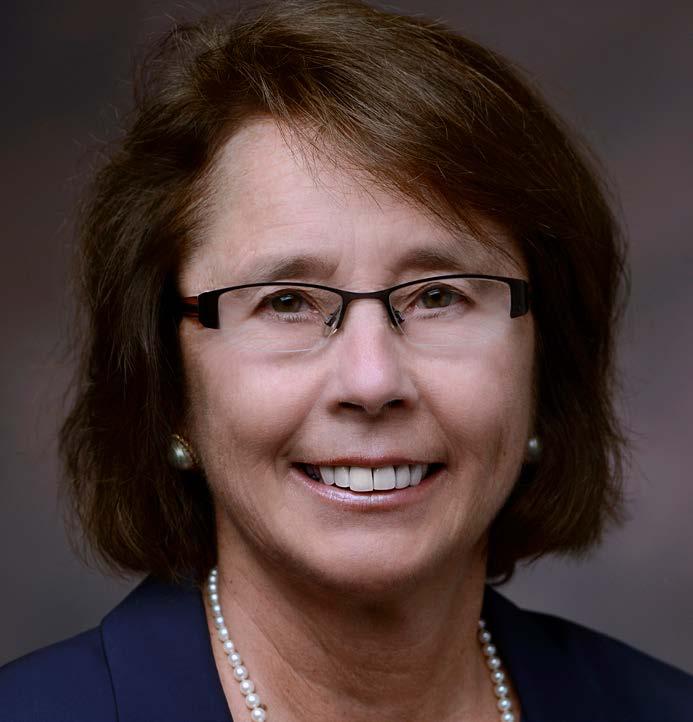
8 minute read
BOG Update
from PAO-HNS Fall 2020 Soundings Newsletter, PUBLISHED IN THE INTEREST OF OUR MEMBERS AND THEIR PATIENTS
by TEAM
Karen A. Rizzo, MD, FACS Governor
On August 3,2020 the Centers for Medicare and Medicaid Services released the 2021 proposed rule for the Medicare Fee Schedule and proposed changes for the Quality Payment Program. The physician fee schedule release came hours after the President signed an Executive Order for the Department of Health and Human Services to promote telehealth use and access. CMS has proposed to retain certain codes for Telehealth services that were temporarily added during the COVID-19 public health emergency and the compensation for them. The 2021 physician fee schedule includes a significant decrease in the conversion factor representing an
Advertisement

almost 11% decrease from 2020. Due to budget neutrality requirements set by law, proposed increases to office payments are being offset by payment reductions in surgery and anesthesia. For Otolaryngology it appears a 7% increase is estimated.
The AAO-HNS urged CMS to sunset temporary waivers involving scope of practice and licensure when the COVID-19 crisis concludes. It reaffirmed its support for the physician led team- based care and opposed efforts to undermine the physician-patient relationship during and after the pandemic. It continues to advocate for Congress to pass legislation that would increase Medicare funded residency positions to help alleviate physician shortages.
Regulatory advances include the BCBS Federal Employee Program now considering Balloon Ostial Dilation as medically necessary for the treatment of chronic sinusitis. The AAO-HNS submitted a position statement to Anthem on hypoglossal nerve stimulation providing extensive literature supporting it as an effective 2nd line treatment for moderate to severe OSA in select patients. A new Academy position statement on Recurrent Respiratory Papillomatosis and Gardasil vaccination was approved as well.

The AAO-HNS promotes use of its Coronavirus Disease Resource website where a comprehensive list of resources for members on Covid-19 issues impacting the specialty are addressed.
Lastly, this year’s Academy meeting was Virtual and encompassed 6 weeks of on demand presentations and sessions that participants could access at their convenience. Dr. Carol Bradford became the new President of the AAO-HNS and Dr. Ken Yanagisawa President elect. Dr. Troy Woodard was elected Chair elect of the BOG and Dr. Lance Manning the new BOG Chair. I continue to serve as the BOG Secretary and on the AAO Nominating Committee. Any member interested in running for an AAO position including Nominating Committee, Audit committee, At Large Director (Academic or Private Practice), and President elect (Academic) please contact me.
Karen A. Rizzo, MD FACS / BOG Governor and Secretary Lancaster Ear, Nose, & Throat
Melissa Montano, MS, CCC-SLP, Erin Kelly, MS, CCC-SLP, Karen Y. Choi, MD
Dysphagia, or difficulty swallowing, is one of the top priorities for functional outcome measurements in patients treated for head and neck cancer, both by patients themselves and by many national and international trials for head and neck cancer (HNC) (such as Eastern Cooperative Oncology Group 3311, PATHOS, and ORATOR). It is also one of the main components of quality of life after cancer treatment and can significantly contribute to development of pneumonias or severe malnutrition, which can potentially be life-threatening if not addressed properly. Furthermore, with the rising incidence of HPV-associated oropharyngeal cancer, the HNC patient population is becoming increasingly younger with improved survival after treatment. As such, there is a growing population of younger, relatively healthy, cancer survivors who are now faced with the devastating and often longterm consequences of treatment, such as pharyngeal dysphagia. In a recent SEER database review from 2002-2011, prevalence of dysphagia was found to be as high as 45% at 2 years after treatment, and was highest in patients treated with chemoradiation and multimodal therapy. Data has shown that there is a significant effect on quality of life for patients who are feeding-tube dependent or even have only mild dysphagia; furthermore, patients who remain NPO for greater than 2 weeks have severe negative impact on long-term swallowing outcomes. In line with these findings, many survivors report dysphagia as the primary reason for decisional regret.
Many large-volume head and neck cancer institutions have implemented a formal dysphagia program in coordination with head and neck surgeons and speech language pathologists (SLP). These programs are comprised of pre- and posttreatment assessments of patient’s functional swallowing, with standardized swallowing exercises and therapy implemented at the start of treatment. Paramount to these assessments include patient-reported outcomes, collected via validated surveys such as the MD Anderson Dysphagia Inventory (MDADI) and the Performance Status Scale – Head and Neck Cancer (PSS-HNC), and outcome measures based on modified barium swallow study results such as the DIGEST (Dynamic Imaging Grade of Swallowing Toxicity). Using these clinical measures, patients at risk for significant dysphagia can then be targeted for an intensive dysphagia therapy program, performed by a certified and trained SLP.
dysphagia intervention
radiation treatment.
There is strong data from larger institutions that show a regimented formal dysphagia program results in improved long-term swallowing and quality of life measures for patients who participate in formal dysphagia pathway program. These patients have a higher probability of eating a regular oral diet long-term, shorter duration of feeding tube dependence, and superior functional status when compared to patients who were not participating in swallow exercises. Chemoradiation induces mucosal inflammation and pain, as well as fibrosis of the pharyngeal musculature. Thus, the importance of continued swallowing during treatment is essential to optimizing long-term quality of life outcomes for these patients.
The HNC disease team at PennState Health Milton S. Hershey Medical Center (PSHMC) launched a formal dysphagia pathway program in 2019 for patients undergoing nonsurgical treatment for HNC. The goal of the program is to allow for a proactive dysphagia intervention strategy by tracking their swallowing function prior to, during, and following radiation treatment. The initial referral to a Speech-Language Pathologist (SLP) prior to treatment initiation is critical in educating patients on the benefits of maintaining nutrition by mouth and exercising the swallowing musculature throughout their course of treatment. Approximately 92% of patients who maintain full oral intake and a swallowing exercise regimen during treatment return to a regular diet following radiation, while only 65% of non-compliant patients may return to their baseline diet. Patients who do not receive pre-radiation swallowing education may be unaware of these risks and often downgrade their diets due to side effects from treatment, including odynophagia, mucositis, dysgeusia, trismus, and xerostomia, all of which contributes to significant negative impact on longterm swallowing outcomes. Furthermore, following completion of HNC treatment, progress with swallowing therapy for these patients may still be limited due to anatomic changes secondary to surgical reconstruction, radiation-induced fibrosis, weakness of pharyngeal muscles, and general fatigue, making it imperative to provide proactive intervention and counseling.
To prevent this, PSHMC patients meet with an SLP prior to beginning radiation to discuss side effects of treatment that may impact swallowing and to emphasize the importance of adhering to a swallowing regimen while also maintaining PO intake to the best of their abilities. Patients are taught pharyngeal swallowing exercises targeting hyolaryngeal elevation, pharyngeal constriction, tongue base retraction, soft palate elevation, and airway protection to prevent dysphagia. Jaw flexibility exercises are also included to prevent trismus and jaw opening measurements are taken regularly to assess progress. Subjective questionnaires are completed to assess how swallowing and side effects of treatment impact patient quality of life. Patients meet regularly with SLP during radiation treatment, and at regular intervals following treatment. A modified barium swallow study is obtained at 3 months post-treatment and based on results of this test, patients at high-risk of
Continued on page 6
Continued from page 5
enrolled in intensive swallowing therapy in an effort to minimize and prevent further swallowing dysfunction. This frequent observation and counseling by SLP following radiation increases compliance with recommendations, aims to prevent long-term dysphagia, and allows for swift intervention to target worsening dysphagia, with the ultimate goal to improve long-term quality of life measures and functional outcomes for our head and neck cancer survivors.


References 1. Mcclelland, S., Andrews, J. Z., Chaudhry, H., Teckie, S., &
Goenka, A. Prophylactic versus reactive gastrostomy tube placement in advanced head and neck cancer treated with definitive chemoradiotherapy: A systematic review.
Oral Oncology 2018; 87: 77-81.
2. Hutcheson, K. A., Bhayani, M. K., Beadle, B. M.,
Gold, K. A., Shinn, E. H., Lai, S. Y., & Lewin, J. Eat and
Exercise During Radiotherapy or Chemoradiotherapy for
Pharyngeal Cancers. JAMA Otolaryngology–Head &
Neck Surgery 2013; 139(11): 1127.
3. Caudell, J. J., Schaner, P. E., Meredith, R. F., Locher,
J. L., Nabell, L. M., Carroll, W. R., et al. Factors
Associated With Long-Term Dysphagia After Definitive
Radiotherapy for Locally Advanced Head-and-
Neck Cancer. International Journal of Radiation
Oncology*Biology*Physics 2009; 73(2): 410-415.
4. Bhayani, M. K., Hutcheson, K. A., Barringer, D. A., Lisec,
A., Alvarez, C. P., Roberts, D. B., et.al. Gastrostomy tube placement in patients with oropharyngeal carcinoma treated with radiotherapy or chemoradiotherapy: Factors affecting placement and dependence. Head & Neck 2013; 35(11): 1634-1640.
5. Orlandi, E., Miceli, R., Infante, G., Mirabile, A., Alterio,
D., Rocca, M. C., . et. al. Predictors of Patient-Reported
Dysphagia Following IMRT Plus Chemotherapy in
Oropharyngeal Cancer. Dysphagia 2018; 34(1): 52-62.
6. Kulbersh, B. D., Rosenthal, E. L., Mcgrew, B. M., Duncan,
R. D., Mccolloch, N. L., Carroll, W. R., & Magnuson, J.
S. Pretreatment, Preoperative Swallowing Exercises May
Improve Dysphagia Quality of Life. The Laryngoscope 2006; 116, 883-886.




